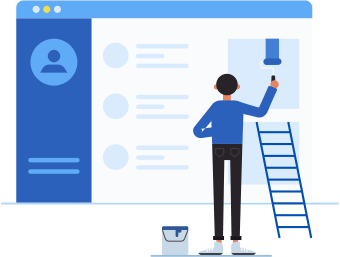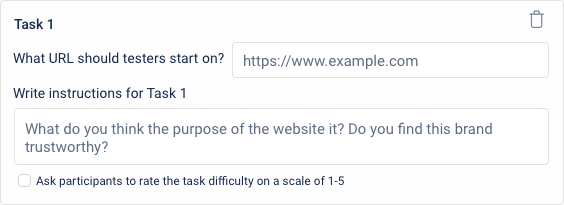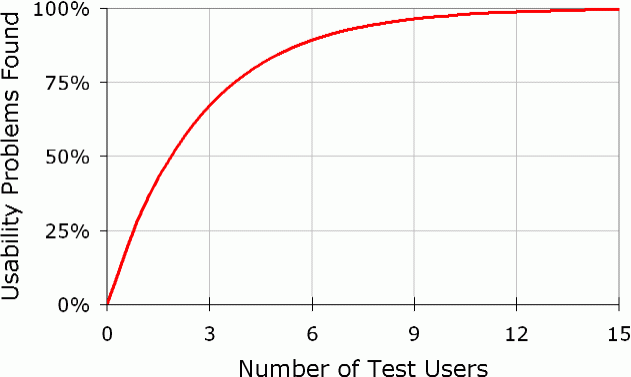Usability Testing
Usability testing is when you test something to make sure it’s intuitive. PlaybookUX is an automated usability testing software that allows you to connect with your target audience. Having real people test your product, website or prototype ensures that it will be easy to use when you roll it out.

Watch videos of people usability testing your product today
What is Usability Testing?
Conduct usability studies so people can find what they’re looking for and accomplish their intended goal. Usability is just another word for making sure your product is intuitive. You can run usability studies on just about anything – websites, products, prototypes and more. It has a lot of benefits – from providing a better experience for your customers to saving your company time on support issues.
Remote Usability Testing
The benefits of remote usability testing are incredible. Make sure your product is easy to use when it’s released by completing a series of remote user tests. It will identify areas for improvement so your product doesn’t fall flat with your target audience. Customer tolerance for low usability isn’t something you want to test!
How do I perform Remote Usability Testing?
Remote usability testing can be performed in moderated or unmoderated sessions. It’s when participants assess the navigation and design of a website, product or prototype. It will help assess usability errors before releasing versions into production.
How many people should I speak to?
Usability testing is qualitative research. Therefore, you’re not looking for statistical significance. With usability studies, 5-8 participants is ideal. The best part is that five participants will uncover 88% of usability issues.
What are popular usability testing methods?
Usability tests come in all shapes and sizes.
- Moderated Interviews
- Unmoderated Research
- Card Sorting
- Tree Testing
- A/B Testing
- Eye Tracking
- 5 Second Test
Moderated Usability Testing
Running a moderated usability study allows you to dig deeper into your customers thought process.
Prior to the session, recruit your target demographic. There are many softwares that can do this for you – like PlaybookUX. Next, create a discussion guide with tasks that you would like to observe participants completing. These tasks can range from things like
- How would you go about contacting us?
- Imagine you’d like to enroll in our newsletter. What action would you take next?
- Please sign up for our product
- Did you complete the previous task successfully?
The benefit of moderated interviews is that you can ask follow up to ensure that customers find it usable. Perform moderated usability tests remotely or live in-person. However, the downside of moderated usability testing is that you may cause participants claim the product is easier to use than it actually is. This is called the observer bias and it’s something to keep in mind as you moderated studies.
![]()
Unmoderated Usability Study
Unmoderated usability studies allow you to cast a wider net than moderated studies, which require you be present for the sessions. Find a software that allows you conduct unmoderated research, like PlaybookUX. Brainstorm tasks and questions to ask testers. Input those tasks and sit back, relax and wait for the videos to roll in.
Once you’ve received videos, watch participants perform a remote usability study on your website, prototype or product.
Test without the manual strain of recruiting, conducting and synthesizing. With unmoderated research, you’ll be able to ask SEQ, SUS and Task Completion questions to assess usability.

The Advantages of Usability Testing
Usability testing is a powerful tool that can transform the way your product looks and feels.
- Improves overall user experience
- Identifies issues with your product that you can quickly fix
- Ensures that people can find what they’re looking for so conversions are improved
- Participants can objectively and unbiasedly give feedback
The Disadvantages of Usability Testing
Usability tests are disadvantageous in certain scenarios.
- Complex topics may require a stronger explanation than typical usability tests
- Participants can be difficult target and recruit
- Synthesis is time consuming
PlaybookUX helps address all three disadvantageous of automated usability testing. Specifically, PlaybookUX allows you to recruit your exact target demographics. Therefore, complex topics may be easier to run a usability test on. Our demographic and employment filters make it easy for B2B and B2C companies alike. Finally, we use artificial intelligence to aid in synthesizing the video sessions and transcripts.
Usability testing benefits
The benefits of usability testing are astonishing. From startups to large enterprises, usability testing is impactful at all levels.
- Provide an improved experience for your future customers
- See if participants can complete tasks successfully in a reasonable period of time
- Identify changes that need to be made to your product
- Avoid support tickets by implementing feedback from the sessions
- Provides an unbiased look at your product
- View authentic reactions while people walk through your product
User Testing Questions
Determining which questions to participants while they test your website or product can be a tall task. That’s why we’ve created question guides. Review our guides on navigation testing, concept testing, first impression testing and more!
Usability Testing Example Video
Watch a real person walk through a website and point out usability issues. Remember: usability studies can be performed on websites, products, prototypes, wireframes and more! This testing session was an unmoderated study, where participants walk through a website while speaking their thoughts aloud. They’ll complete tasks to determine if the website it easy to navigate.

of developers time is spent fixing issues that could have been avoided during the prototyping phase

times more expensive to fix a problem in a product that’s already been released than it is during the prototyping phase
Hallway Usability Testing
Hallway usability testing is when you visit a high traffic zone and recruit people to take 5-10 minutes out of their day to test your software.
Advantages of hallway usability testing
- It’s simple, cheap and effective software testing technique.
- Doesn’t require significant planning
- Provides quick insights into the software’s UI and design and allows you to improve usability
- Allows you to gain user feedback to help iterate and improve the software’s UX.
Disadvantages of hallway usability testing
- You’re limited by the people who are walking through the place you’re testing
- Some people may not be willing to help based on the day and time of your hallway testing. For example if it’s a Friday afternoon and people would rather get home after a long week.
- People may not be totally honest since the observer effect is in play.
Usability testing best practices for agile teams
Usability testing should be a company wide initiative, especially for agile teams. Setting up a repeatable process of testing starts with the software you use. PlaybookUX allows you to conduct automated usability testing with unlimited team members.
- Determine the software.
- Define your testing goals
- Prepare questions if it’s an unmoderated study or discussion guide for a moderated study
- Conduct the study
- Analyze the results
- Share the results with your team and create JIRA stories based on findings
Once you’ve tested and implemented the changes, it’s important to repeat regularly. The most successful companies follow the usability testing best practices above by continuously run usability tests.
How do I prioritize my findings?
There are a few ways that you can prioritize research. First, look for points of consensus.
If many people are asking for it, find it difficult or don’t understand it, then it’s probably a good idea to tackle that first.
Second, if the issue makes it impossible to complete a task, that’s pretty important. Specifically if that task involves achieving a key goal, like signing up for your platform or paying for your order. Those aren’t things you want to sleep on since they’re essential to your business. On the other hand, if customers can’t find the notifications page, it’s not a make or break situation. It’s a nice to have but not essential.
Usability Study Logistics
There’s a lot of manual work involved in running usability studies. All of them start with an email. Review our usability testing recruitment email guides for hassle free scheduling! Once you’ve scheduled participants, use our usability testing non disclosure agreement pdf to protect your confidential information.
Usability Metrics
Important usability metrics are SUS, SEQ and Task Completion. They’ll help measure usability within each test and also benchmark usability so you can track your improvements between each successive study.
What is System usability scale (SUS)?
It provides a quick estimate of a system’s usability. Asking SUS questions the end of unmoderated sessions in a post-interview questionnaire will allow participants to reflect on the study. Participants answer a variety of questions on a scale of 1 to 5.
What is Single Ease Question (SEQ)?
SEQ is a 7-point rating scale that measures how difficult participants find a task. When relevant, after each task ask participants “Overall, how difficult or easy was the task to complete?” Participants will rate the task on a scale from very easy to very difficult.

Why are Task Completion questions important?
A task completion question is when you ask participants “Did you successfully complete the task?” Participants can choose from yes, no and I don’t know. It will help you understand if participant’s perception is in line with their actual performance.
For example, if participants think that they completed a task, but in fact they didn’t, then there’s a big usability issue to address. Participants should know if they completed a task because it should be clear. Usability issues can help UX Writers create a better narrative while walking through the product.
General FAQ
What is usability testing?
It's the process of making a website, product or prototype intuitive.
What's the future of usability testing?
The manual parts of usability studies will become more automated. Therefore, you won't have to manage the operations of recruiting, conducting, transcribing, and analyzing the research sessions.
Why does usability testing matter?
If people can’t find what they’re looking for, they’ll abandon your product. User testing increases conversions, decreases bounce rate and enhances customer satisfaction.
What are the most common usability testing methods?
It is usually conducted through unmoderated and moderated user tests. However, card sorting and tree testing are other popular methods.
How many participants do you need for a usability study?
Testing doesn't need to break the bank. 6-8 participants is sufficient to identify 88% of all usability issues.
Does PlaybookUX allow you to conduct usability testing?
Yes! PlaybookUX connects you with your target demographic to conduct usability research.
Get Feedback, Fast
PlaybookUX is trusted by top enterprises across the world.



